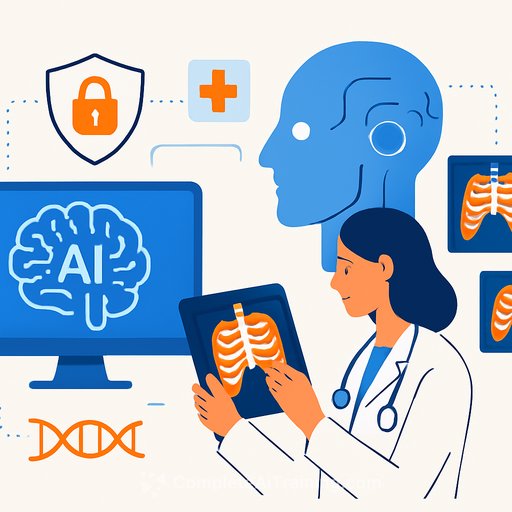Synthetic medical imaging: accelerating AI in healthcare while protecting privacy
AI can help clinicians detect disease earlier, improve diagnostic accuracy, and make care decisions with more confidence. But AI only works if it's trained on trustworthy data that reflects real patient diversity. That's the hard part. Clinical data is fragmented, sensitive, and tough to share across sites and vendors.
Without new approaches, many models will stay stuck in pilots because the data behind them can't scale. Synthetic medical imaging offers a practical way forward.
Introducing synthetic medical images
We're exploring realistic, algorithmically generated CT and MRI datasets that mirror clinical variation while protecting patient privacy. Large synthetic cohorts let models learn from broader populations and rare findings, increasing accuracy and reliability without exposing identifiable information.
Disclaimer: These images were produced as part of exploratory research into synthetic medical imaging and do not represent finalized outputs or validated clinical use cases.
Advancing AI systems with synthetic data
As a key partner of Project SEARCH-a collaborative effort to apply synthetic data to medical imaging analysis-we bring imaging software experience, AI expertise, and clinical depth across care settings. The goal is simple: make synthetic datasets technically sound and clinically meaningful so clinicians can trust the outputs.
- Oncology: Use synthetic CT and MRI to support earlier detection and more precise characterization of lung and liver tumors.
- Cardiovascular care: Develop synthetic datasets that strengthen algorithms for diagnosis, treatment planning, and clinical decision-making.
These applications help close gaps in existing training data, shorten development time, and improve model performance-while reducing privacy risk.
Building medical professionals' trust in synthetic imaging data
Project SEARCH goes beyond generating look-alike images. Together with clinical partners, we're defining a validation framework for image quality, privacy protection, and clinical relevance. Early work using synthetic CT for tumor detection and classification shows encouraging signals in feasibility testing.
Insights from this effort will guide expansion into cardiovascular applications and progress toward a multi-modality engine that supports a wide range of diagnostic use cases.
Why it matters for healthcare teams
Synthetic medical data isn't just a technical win-it enables responsible, people-centered AI. It accelerates innovation without compromising patient trust. Done well, it equips clinicians, strengthens providers, and contributes to better outcomes.
Through our role in SEARCH, we're helping move healthcare AI forward in ways that are safe and scalable, focused on what matters most: improving health and well-being through meaningful innovation.
Practical steps to get started
- Identify dataset gaps: rare conditions, underrepresented demographics, and edge cases that limit model performance.
- Run a focused pilot: pick one use case, define clear success criteria, and compare model performance with and without synthetic data.
- Validate with clinicians: confirm pathology fidelity, image quality, and decision impact at the case level.
- Assess privacy risk: combine technical reviews with policy controls and document how synthetic data differs from de-identified data. See HIPAA de-identification guidance from HHS: HHS HIPAA De-identification.
- Align with AI safety guidance: tie your processes to recognized principles for medical AI development (e.g., FDA's guidance on AI/ML in SaMD: FDA AI/ML for SaMD).
Learn more
- AI learning paths by job role for clinicians, data scientists, and healthcare leaders.
- Latest AI courses to keep teams current on imaging, privacy, and safety.
Your membership also unlocks:






